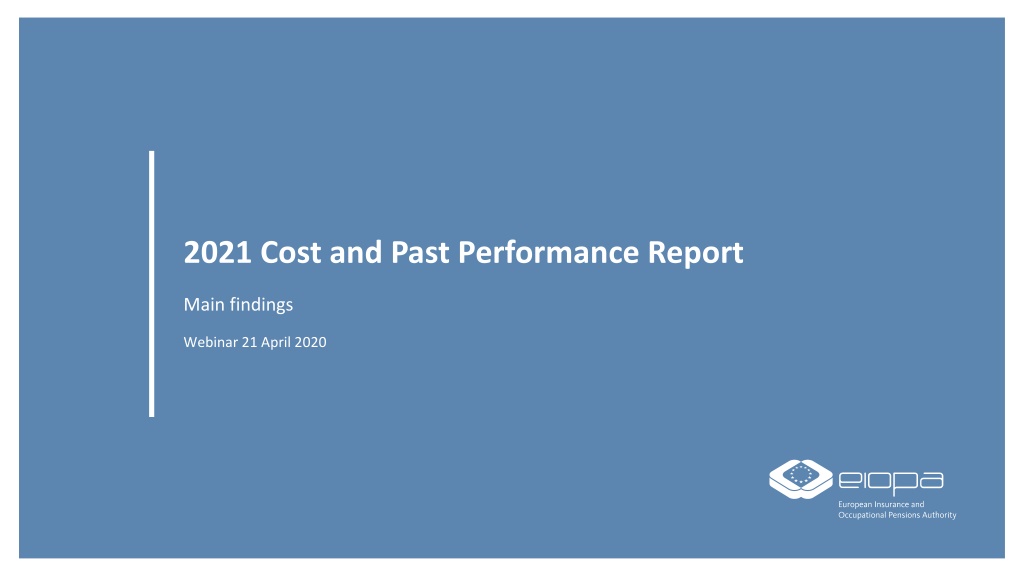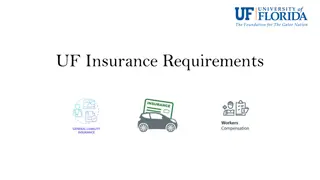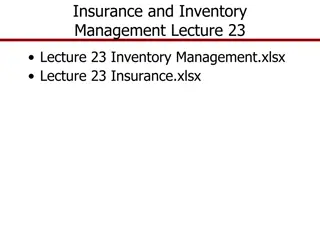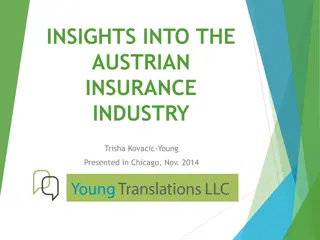European Insurance Based Investment Products (IBIPs) Market Analysis 2021
The 2021 Cost and Past Performance Report provides insights into the European Insurance Based Investment Products (IBIPs) market, highlighting key findings such as growth rates, net returns, and cost comparisons between profit participation, unit-linked, and hybrid products. The report indicates a positive trend in the market but also addresses challenges in assessing hybrid products. Overall, the analysis offers a comprehensive overview of the IBIPs market landscape in Europe.
Download Presentation

Please find below an Image/Link to download the presentation.
The content on the website is provided AS IS for your information and personal use only. It may not be sold, licensed, or shared on other websites without obtaining consent from the author. Download presentation by click this link. If you encounter any issues during the download, it is possible that the publisher has removed the file from their server.
E N D
Presentation Transcript
2021 Cost and Past Performance Report Main findings Webinar 21 April 2020
Content 1. Overview of the main findings on IBIPs and PPPs 2. Issues identified 3. Upcoming
The European Insurance Based Investment Products (IBIPs) market GWP - million (LHS) and YoY growth rate (RHS) The findings are based on a sample covering more than 680 Insurances based investment products (IBIPs) being marketed by over 160 insurance undertakings covering the 60% of the European IBIPs market With the increasing shift from traditional profit participation products to products with less guarantees, hybrid products are becoming more and more common. Being relevant in FR, IT, LU, HU, AT, DE Hybrid products
IBIPs main findings 2019 was an extremely positive year for the IBIPs market at European level and positive net return across all Members States, in line with general market trends. The net performance of profit participation products,despite being steadily positive in all years of the analysis, is low, in particular when considering the impact inflation can have in some markets. Profit participation products continue to be less costly than unit-linked and hybrid products. The performance of unit-linked products varies according to the level of risk being taken, while for profit participation products, the recommended holding period is the main factor. On hybrid products while these seek to combine the benefits of profit-participation and unit-linked products, they are generally more costly and complex, raising some potential challenges in assessing them.
60 Net Returns and Costs of IBIPs in Europe UL volatility is high: 2019 net return was extremely positive 50 40 30 PP products continue to offer stable, despite generally especially when considering the impact of inflation 20 UL low, returns 10 0 24% 27% -39% -36% -9% -6% -3% 12% 15% 18% 21% 30% 33% 36% 39% 42% 45% 48% 51% 54% 57% 60% -60% -57% -54% -51% -48% -45% -42% -33% -30% -27% -24% -21% -18% -15% -12% 0% 3% 6% 9% Net Return 2018 Net Return 2017 Net Return 2016 Net Return 2015 Net Return 2019-2015 - Yearly Compounded Avg Net Return 2019 UL Net Return Cost 2019 (as RIY at RHP) 11.4%, median EEA 2019 40 2.7%, median EEA 2019-2015 35 UL: 2.5% PP: 1.5% Hybrid: 2.1% 30 PP Net Return 25 1.2%, median EEA 2019 20 15 1.4%, median EEA 2019-2015 10 PP 5 Hybrid Net Return 0 -15%-14%-13%-12%-11%-10% -9% -8% -7% -6% -5% -4% -3% -2% -1% 0% 1% 2% 3% 4% 5% 6% 7% 8% 9% 10% 11% 12% 13% 14% 15% 5.0%, median EEA 2019 Net Return 2018 Net Return 2017 Net Return 2016 Net Return 2015 Net Return 2019-2015 - Yearly Compounded Avg Net Return 2019 2.1%, median EEA 2019-2015
Net return by Member State - IBIPs 25% 20% 19% 19% 18% 20% 18% 15% 15% 2019 was an extremely positive year for the IBIPs market at European level 14% 14% 14% 14% 14% UL 13% 15% 13% 13% 10% 9% 10% 8% 8% 8% 7% 6% 6% 6% 6% 5% 5% 5% 5% 4% 4% 4% 4% 3% 5% 3% 2% 2% 2% 2% 2% 2% 1% 1% 0% 0% AT BE BG CZ DE EL ES FI FR HR HU IE ST deviation 2019-2015 IT LI LU NL PL PT RO SE SI SK Yearly NR 2019-2015 Weighted_NR_UL_2019 When considering the inflation effect, the value consumers has been on average very little in real terms, particularly PP products. offered to 4.5% 3.9% 4.0% 3.4% 3.5% 2.7% 3.0% 2.7% PP 2.3% 2.5% 2.0% 1.9% 2.0% 1.5% 1.5% 1.4% 1.4% 1.3% 1.2% 1.2% 1.5% 1.1% 1.1% 1.1% 1.1% 1.0% 1.0% 1.0% 1.0% 1.0% 0.5% 0.5% 0.4% 0.4% 0.3% 0.5% 0.1% -0.2% -0.1% 0.0% Trends amongst different Member States are homogeneous, with UL net return always higer than PP and Hybrid. -0.5% AT BE BG Yearly NR 2019-2015 CZ DE EL HR Weighted_NR_PP_2019 HU IT PL PT RO SE SI SK ST deviation 2019-2015 10% 8.4% 8.2% 7.0% 8% 5.9% 5.4% Hy 5.2% 6% 3% 4% 2% 2% 2% 2.0% 2% 2% 2% 0% -2% -2% -4% AT BE DE FR IT LU SK Yearly NR 2019-2015 Weighted_NR_HY_2019 ST deviation 2019-2015
Cost by Member State - IBIPs 3.7% 3.7% 3.6% 4.0% 3.3% 3.2% 2.8% 2.8% 2.7% 2.7% 2.6% 3.0% 2.4% 2.5% On average, PP are less costly than UL products. 2.4% 2.3% 2.2% 2.1% 2.0% 2.0% 2.5% UL 1.8% 1.8% 2.0% 1.4% 1.1% 1.0% 0.0% AT BE BG CZ DE EL ES FI FR HR HU IE IT LI LU NL PL PT RO SE SI SK From a value for money perspective, some need considered in terms of returns and costs for hybrid products. Their costs higher while still offering lower return than UL. RIY_Entry costs RIY_Exit Costs RIY_Transaction costs RIY_Other ongoing costs RIY_Performance fees RIY_Wrapper Costs RIY_at_RHP 4.0% 3.5% trade-offs to 3.5% 2.8% 2.6% be 3.0% PP 2.5% 2.1% 2.0% 2.0% 1.8% 1.8% 2.0% 1.5% 1.5% 1.4% 1.4% 1.5% 1.3% 1.5% 1.1% 1.0% 0.6% 0.5% 0.0% are PP AT BE BG CZ DE EL HR HU IT PL PT RO SE SI SK than RIY_Entry costs RIY_Exit Costs RIY_Transaction costs RIY_Other ongoing costs RIY_Performance fees RIY_at_RHP 6.0% 5.5% 5.0% 4.1% 3.6% 4.0% Hy 3.0% 2.4% 2.1% 2.2% 2.1% 2.0% 2.0% 1.2% 1.0% 0.0% AT BE DE EL FR IT LU SK RIY at RHP EEA median
2. Recommended Holding Period Net return - IBIPs 1. Risk Class UL PP UL PP 3. Premium Frequency PP UL Higher net return correlates with higher risk classes for UL products, while for PP the correlation is inverse and less marked Products with a longer RHP proved to pay a higher net return for both UL and PP products but more remarked for PP No clear correlation between the net return and premium frequency could be observed.
2. Recommended Holding Period Costs - IBIPs 1. Risk Class UL PP UL PP 3. Premium Frequency UL PP Costs are much more homogeneous than net returns when considering different risk classes, RHP, and premium frequency. Short-term products are more costly than the longer term ones. Costs for regular premium products are higher in both UL and PP products.
Personal Pension Products - PPPs Trends in the net return and costs of are similar to those observed for IBIPs: higher average annual return but also higher volatility for personal pension products similar to unit-linked (PPP-UL) in comparison with personal pension products similar to profit participation products (PPP-PP). Costs were lower for PPP-UL than for IBIPs. A longer recommended holding period is also identified as a driver of extra performance, in particular in relation to product similar to profit participation. Being pension products, by their nature, characterized by longer time duration the relation is more marked than in IBIPs. Amongst different Members States trends in net return were homogenous, with PPP-UL net return in 2019 being extremely positive. Challenges due to the lack of harmonization are still relevant
Net Returns and Costs of PPPs - EEA Similar to IBIPs, the net returns of PPPs similar to UL has higher volatility than those similar to PP The performance of PPPs is better than IBIPs both in terms of costs and net return UL Despite the diversity in the national framework on PPPs, trends amongst different markets are homogeneous PPP-UL Net Return 14.1%, median EEA 2019 Cost 2019 (as RIY at RHP) 3.5%, median EEA 2019-2015 PPP-PP Net Return UL: 1.9% PP: 1.6% PP 1.2%, median EEA 2019 1.4%, median EEA 2019-2015
1. Overview of the main findings on IBIPs and PPPs 2. Issues identified 3. Upcoming
2. Issues identified Value for money: instances of high costs or low-negative net return have been reported, raising questions on value for money in particular taking into account the inflation effect. Complex costs structure: for some products it is difficult to get the total cost information because of the different layers wrapper and underline and the different points time in which costs are charged Lack of harmonization: persistent challenges especially related to PPPs, where no European framework is available
1. of the main findings on IBIPs and PPPs 2. Issues identified 3. Upcoming
3. Upcoming Pension Products - IORPs: Extended analysis, including more detailed analysis on cost levels by AC, Member States and on DC schemes at aggregate level. PPPs: Further work on standardization and harmonization of the data collected - IBIPs - ESG Products EIOPA plan to introduce some analysis comparing costs and past performance of ESG and non ESG products Next steps Costs Transparency Costs are often high and opaque, it is difficult to understand if they are due and in line with peers products hence EIOPA would keep up working on the data collection
THANK YOU! For more information visit: https://www.eiopa.europa.eu























